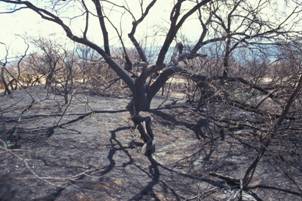
LAND IMPRINTING RESTORATION: FIRE-DISTURBED LAND
October 3, 2005
R.M. Dixon
When land is disturbed by fire followed by rain, a destructive series of events often occur. Fire causes the soil to become water repellent or hydrophobic and ashes smooth the surface and plug surface-connected macropores. When an intense rainstorm event occurs, the combination of soil water repellency and an ash-smoothed and clogged soil surface work together to cause nearly zero infiltration and thus rapid water runoff and soil erosion, and downslope flash flooding and sedimentation of the eroded ashes and soil. Such erosion further increases the hydraulic smoothness (decreases hydraulic roughness) and decreases surface macroporosity, thereby further decreasing the potential for water absorption into the soil during subsequent rainstorm events. Thus a vicious cycle of land degradation ensues which is not conducive to ecological restoration, in fact just the opposite.
Fortunately, the new land treatment called land imprinting is designed to reverse this trend of land degradation following fire. The land imprinter makes V-shaped pockets in burned land that cut through the hydrophobic layer and pond several inches of rainwater in the Vee, thereby providing the hydraulic head required for rapid infiltration. Once the soil is rehydrated, seeds can germinate and seedlings can become established to initiate ecological restoration of the fire-disturbed land. The imprinted pockets are closed micro-watersheds 1-foot-square in size, thus there are 43,560 imprints per acre. Each imprint can pond several liters of rainwater for subsequent infiltration.
Imprinters can form seedbeds and apply a seed mix, inoculants of fungi and bacteria; and pelletized mulches in a single operation without initial tillage. The seed mix should include a cover crop of rapid growing annual grasses to quickly stabilize the imprints and provide a food source for surface feeding soil invertebrates that increase rainwater infiltration by perforating the soil with their surface-connected burrows. Applied mulch pellets can provide a food source while the cover crop is becoming established. The seed mix should include early, mid and late successional species-about a third of each by weight of pure live seed PLS as a first approximation. The application rate of PLS should range from 10 to 15 pounds per acre. The mix of seeds, inoculants, and mulch pellets is dropped on top of the imprinting roller where it is carried forward by the revolving roller and dropped on the soil surface to then become imbedded in the V-shaped faces of the imprints. Each subsequent rainstorm washes some of the applied resources down into the bottom of the Vee where they can work in concert to germinate seeds and establish seedlings. In aridlands this process may proceed for several years until a good stand of seeded vegetation finally arises. Thus, imprinting provides a wide time-window (up to 5 years) of opportunity for successful plant community establishment. The alternative seed drilling method makes a seedbed that is often washed out with the first rainstorm. This is because the continuous drill furrows tend to bleed applied resources downslope off of the burned land area to be deposited with the eroded ash and soil sediments in relatively level areas below.
Imprinters work best when current design and operation standards are met-standards that are published elsewhere. Land imprinting restores fire-disturbed land by accelerating water infiltration into hydrophobic soil.
Photo: Fire disturbed rangeland, Catalina , AZThe Imprinting Foundation
1616 E. Lind Road
Tucson, AZ 85719Close Window to Return to List
If you entered our site on this page, click on Logo below to go to the Imprinting Foundation for more Information

